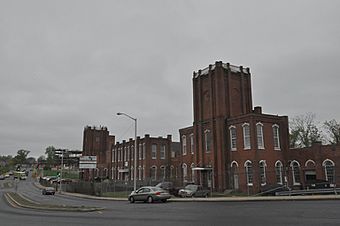Water Shops Armory facts for kids
Quick facts for kids |
|
|
Water Shops Armory
|
|
 |
|
| Location | 1 Allen St Springfield, Massachusetts |
|---|---|
| Area | 4.6 acres (1.9 ha) |
| Architect | United States Army |
| NRHP reference No. | 80000476 |
| Added to NRHP | December 3, 1980 |
The Water Shops Armory was a very important part of the Springfield Armory in Springfield, Massachusetts. You can find it at 1 Allen Street. This place started being built in 1857. It was where all the big, heavy work for making weapons happened. Because of its history, it was added to the National Register of Historic Places in 1980.
Contents
What Was the Water Shops Armory?
The main Springfield Armory was a huge place. It covered two city blocks. This part was called the Hill Shops. Today, a national park and Springfield Technical Community College are there.
Why Was the Water Shops Armory Built?
About a mile (1.6 km) south of the main armory, the United States Army built the Water Shops. This area was special. It was located right by the Mill River. The river's power was used for heavy metal work. This included shaping gun parts and making gun stocks.
How Water Power Helped
The Mill River provided water power. This was very important for the factories. It helped run the machines that did the heavy work. This made the Water Shops a perfect place for manufacturing.
History of the Water Shops
When the Springfield Armory first started in 1794, early workshops were set up along the Mill River. These workshops were at three different waterfalls.
Building the Modern Water Shops
In the 1850s, all these smaller workshops were brought together. They became one big site. The first of the buildings you see today was built in 1857. Over the next four years, more buildings were added. This made the Water Shops very strong. It could handle all the heavy manufacturing the armory needed.
Powering the Factories
A dam and a canal were built. This raised the water level of Watershops Pond. New water turbines were also installed. These turbines provided 300 horsepower. This was a lot of power for the factories.
What Happened to the Water Shops Armory?
Today, the Water Shops complex is owned by a private company. It is still an industrial site. A big fire happened on June 17, 1988. It badly damaged the main building. Part of the top floors were destroyed. The building was built in two parts. The first part was from 1858. The second part, built in 1901, was where the fire happened.

